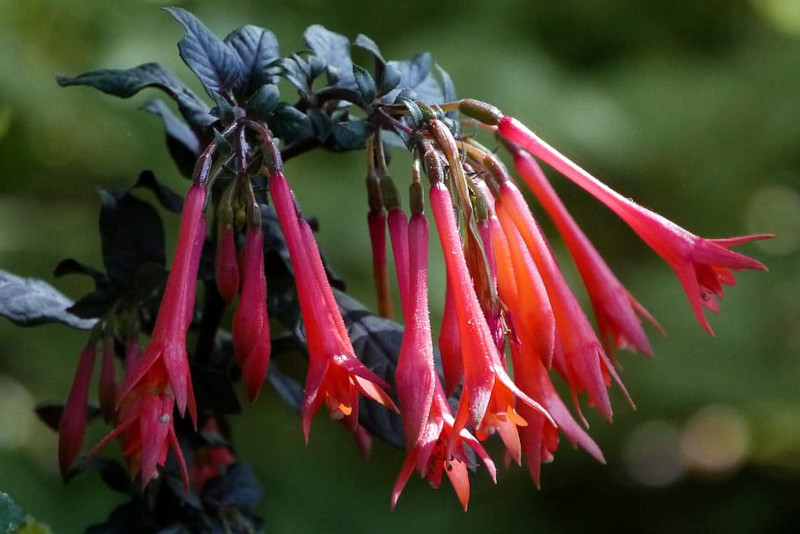
Coral Honeysuckle Facts
- This dazzling Angiosperm is most frequently referred to by the descriptive common name of the Coral Honeysuckle. It does have a few other, less often used titles, though, Those include such terms as the scarlet honeysuckle and the trumpet honeysuckle.
- Each of these remain far simpler for the layperson to pronounce than its technical title. That’s because, in scientific circles, it’s much better known by its official moniker. The plant, however, bears the tongue-twisting formal name of the Lonicera sempervirens.
- It received that difficult appellation due to the efforts of the esteemed Swedish botanist, Carl Linnaeus. He achieved the first official acknowledgement of it as a separate and distinct species. That scientifically noteworthy deed occurred in 1753.
- Fortunately, the Coral Honeysuckle seems to be maintaing a population base that’s both stable and sufficient. That situation further appears to hold true throughout the entirety of its range. The IUCN thus has no listing for the species at this time.
- The marvel of Nature nevertheless faces several potential threats to its existence, at least. Most of these stem from the actions of humans. They include such possible perils as habitat degradation and loss. Its’ greatest threat, though, consists of climate change.
Related Articles
Coral Honeysuckle Physical Description
The gorgeous Coral Honeysuckle truly merits the appreciation of those who encounter it growing in its native environment. It also does so for several reasons, not just its simple yet elegant beauty. That’s because it also attains some reasonably impressive measurements.
This creation of evolution develops as a highly twisting vine. The thin central stem it produces often grows to lengths of as much as 20 ft (6.1 m). The flora extends its length either along the ground, or vertically when in the company of shrubs, bushes, or trees.
This marvel of Nature additionally develops very attractive foliage. Its leaves appear in opposing pairs, and possess a smooth, glossy texture. These also have a semi-evergreen nature. Each also averages roughly 2 in (5 cm) in length, and about 1.6 in (4 cm) in width.
The stems of the plant, both primary and secondary, display yet another intriguing aspect. When younger, these show a light green shade, and have a fuzzy coating. As these age, however, that changes. They change from this to a light brown and then a red-orange hue.
The fruits of the beautiful Coral Honeysuckle manifest in relatively large numbers. This part of the species also shows a brilliant, eye-catching shade of red. It develops as a tiny berry, though, typically measuring less than 04. in (1 cm) in terms of both its length and width.
Yet, it’s the flowers of the remarkable plant that garner the most attention. They also serve as the source of its common name. These blooms usually develop in clusters of 4 -5 flowers. Each displays a decidedly trumpet-shaped form, and shows either a coral or reddish color.
- Kingdom: Plantae
- Phylum: Tracheophytes
- Class: Eudicots
- Order: Dipsacales
- Family: Caprifoliaceae
- Genus: Lonicera
- Species: L. sempervirens
Coral Honeysuckle Distribution, Habitat, and Ecology
The visually stunning Coral Honeysuckle evolved as native to only a moderate expanse of the globe. The precise region within that greater area, though, likely comes as no surprise to many people. That’s true since it developed as endemic to a portion of North America.
There, this wonder of creation appears naturally in a thin range extending down the east coast of the United States. Originally, that zone of habitation ran from southern Maine to Florida, and then to Texas. Human activities, however, have now spread it beyond that area.
The botanical beauty also evolved a combination of habitat requirements. Regarding its soil needs, therefore, it’s quite flexible in terms on where it appears. It grows equally well in such types as loamy, sandy, clay, and acidic, though it does prefer richer types.
Yet its needs remain specific regarding conditions. The flora needs excellent air circulation, lots of light, and adequate drainage, as it does not tolerate excessive moisture. The regions it most commonly appears in include temperate forests with moderate undergrowth.
The lovely Coral Honeysuckle developed as a perennial plant. It achieves pollination via the actions of various local insect species, especially bumblebees. Yet the flora also represents a popular plant among many species of hummingbirds sharing its zone of habitation.
The characteristic blooms typically appear between March and June. Numerous species of birds consume the bright berries, including quail and robins. Parts of the Angiosperm also host uses in herbal remedies. Its uses include treatments for asthma, bee stings and coughs.
Species Sharing Its Range
Check out our other articles on 4 Remarkably Evolved Reptiles, Eastern Gray Squirrel, Great Barrier Reef, Halloween Hermit Crab, Axolotl, Mangrove Monitor, Nicobar Pigeon, Evening Cicada
